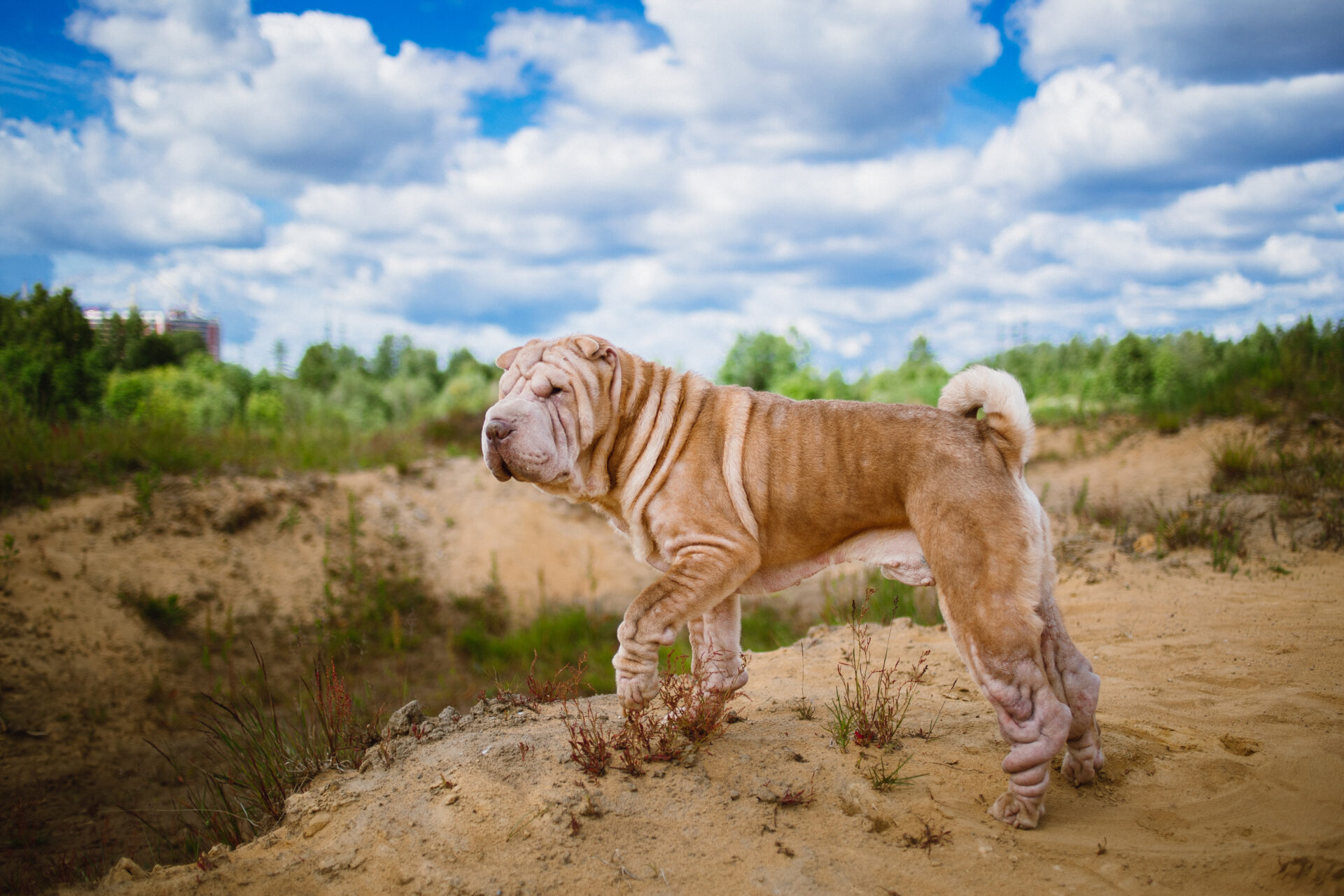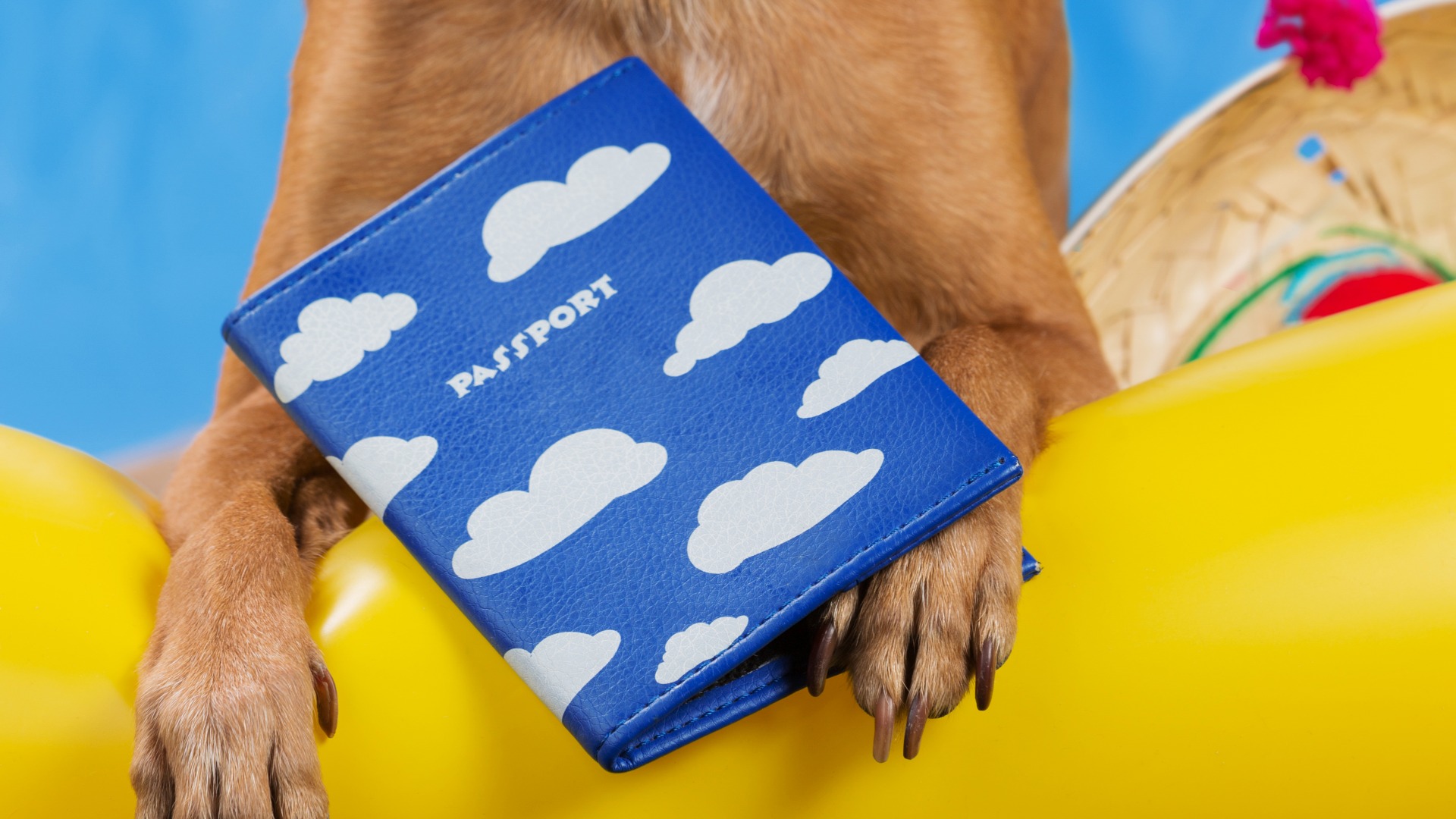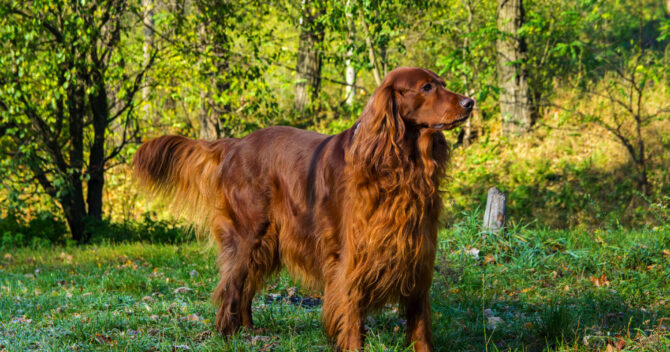. Shar Pei – the history of the breed
The name "shar pei" comes from the Cantonese expression "sa pieh", which means "sand skin" and refers to the rough, bristly fur of the breed's representatives. Native to the southern provinces of China, the Shar Pei has a 2000-year history that dates back to the Han Dynasty. This hardy, intelligent dog was used by Chinese farmers to hunt, guard and protect livestock from predators and thieves. For most of its history, the Shar Pei was considered a fighting dog, fighting alongside Roman legionaries, among others, and carrying cauldrons of boiling tar during wars in the Middle Ages. Written records show that representatives of this breed were also used for dog fighting. There is reason to believe that then these animals were much larger and their weight reached up to 80 kilograms.
Strong jaws and prickly fur were an asset in battles, and the folds protected the most sensitive areas from damage. When the communist Chinese government imposed a huge tax on all dogs in the 40s, Shar-Pei breeding virtually disappeared. However, the persistent efforts of breeders from Hong Kong and the United States ensured the breed's survival. The first breed standard was approved in 1976. According to the FCI classification, Shar Peis belong to the second group: schnauzers, pinschers, Swiss mountain dogs, related breeds, and the second section: Molossians, Great Dane type.
Suggested sizes and widths of accessories for this breed of dog:
Here are the suggested sizes for adult dogs of this breed. They were selected on the basis of many years of experience in sewing accessories and the most common choices of other dog owners of this breed. Remember, only measuring will give you 100% certainty - every dog is different.
The appearance of the Shar Pei
The Shar Pei is a compact, stocky dog with a square shape. Its unique appearance is given by the skin folds on the head and withers, small ears and the so-called "Hippopotamus" of the muzzle. Males are taller and more muscular, about 50 cm tall at the withers and weigh 23-25 kg, while females grow to an average height of 45 cm and weigh 20-22 kg.
- Head - broad and flat, with a moderate stop between the crown and a broad, strong muzzle that does not narrow towards the nose. The folds of skin around the forehead and eyes make the dog frown, even when relaxed.
- Ears - very small in proportion to the dog's proportions, they are triangular in shape and fold towards the front.
- Eyes - medium-sized, almond-shaped, varying in color depending on the color of the coat.
- Jaws - powerful (scissor bite). The pigmentation of the gums, lips and tongue is pronounced: they should be bluish-black, although in some representatives they have a lavender shade.
- Foliage - it should be the same length from the withers to the buttocks as the height from the ground to the withers.
- Fore and hind limbs - clearly muscled, giving a strong, athletic appearance (skin folds are undesirable).
- Tail - thick at the base, tapering to a thin tip.
- Hair - consists only of topcoat hair, no undercoat. Short and coarse, it feels like stubble. It may be of any solid color except white. The most common are: red, black, chocolate, apricot, cream, blue and lavender. Stains are not allowed, although darker (along the spine and on the ears) and lighter (tail and back of the thighs) areas of the hair are possible.
Character
The Shar Pei is an intelligent, independent, moderately active "philosopher". Above all, he is the guardian and guardian of his family. He is extremely open and sociable towards his loved ones and likes spending time with them. He is distinguished by great kindness, cordiality and devotion. However, when it comes to strangers, he is generally withdrawn, uncommunicative and distrustful. Therefore, it will usually closely monitor the behavior of strangers and will immediately defend itself when threatened. To avoid aggression towards other animals and strangers, the Shar Pei is socialized from an early age and taught to respond calmly to various external stimuli.
The representative of this breed, despite obedience and devotion to the owner, is characterized by a strong character, proud and independent demeanor, therefore he needs an experienced and patient guardian who deserves the authority and recognition in the eyes of the animal. Shar Pei feels good in an apartment (even a small one), and when left alone, it does not show any tendency to destruction and mess in the house. Although his energy level is not very high, he does need walking and exercise (about an hour a day) to keep his muscles in good shape.
Health
The diseases affecting this breed include:
- Shar Pei fevermanifested by swelling of the ankle joint (one or both), as a consequence of a sudden increase in temperature to 39-42 ° C, accompanied by abdominal pain, vomiting, diarrhea. It is believed to be hereditary. Usually appears at 18 months of age. Therapy is based on conservative treatment that allows to alleviate the symptoms of the disease. Medications are given to lower the temperature and lower the pain threshold.
- Hypothyroidismwhich leads to epilepsy, alopecia, obesity, hyperpigmentation, pyoderma (pyoderma) and other dermatological problems, and in particularly severe cases to lethargy. Treatment consists of the administration of hormonal drugs and dietary changes.
- Elbow or hip dysplasia is a degenerative disease that can lead to arthritis and lameness.
- Demodex - the appearance of areas of red, scaly skin, hair loss due to infection with skin parasites.
- Pyoderma is a bacterial infection that causes pus to build up in the outer layers of the skin and near the hair follicles.
- Seborrhea is an inflammation of the skin, which is most often the result of allergic, infectious and parasitic diseases as well as problems with the immune system, endocrine system or metabolism.
- Patellar dislocation - congenital or acquired dislocation of the kneecap in relation to the normal position.
- Osteochondrosis - abnormal cartilage growth, causing painful stiffness in the joint. Torsion of the stomach is a dangerous condition that causes the stomach to swell with trapped air, by absorbing too much food too quickly. This leads to a violation of normal blood flow and a sharp drop in pressure. Requires immediate veterinary attention! Alarming symptoms include restless behavior, gas, excessive salivation, and ineffective gag reflexes.
- Glaucoma Increased pressure in the eye, leading to optic atrophy and loss of vision.
- Entropion is an abnormal position of the eyelids, in which the free edge of the lower (rarely upper) eyelid curves towards the eyeball and constantly damages its surface, causing inflammation of the cornea and, consequently, loss of vision.
The average life expectancy of Shar Pei dogs is 9-11 years.
Care
Keeping your Shar Pei's short hair looking beautiful and healthy is not difficult. However, constant monitoring of skin folds is required, as they are particularly sensitive and prone to inflammation. Regular brushing and bathing with a neutral pH shampoo are enough to maintain a healthy coat. However, it should be emphasized that representatives of this breed generally do not like water treatments. It is worth getting them used to grooming from puppyhood. After bathing, dry the skin in the folds as thoroughly as possible, preferably with a hairdryer, you can also use talcum powder or a special powder for dogs.
You can use a rubber glove or a short-haired brush to clean the shar-pei's hair. During the moulting season (spring and fall), brush the coat more often than in other periods. Like all other dogs, a shar pei also requires regular eye, tooth, ear, and claw care. Be extremely careful when cleaning your ears as shar pei have thin ear canals that can be easily damaged. Therefore, it is worth taking advantage of the advice of a specialist who will show and explain how to properly care for your pet's ears.
Interesting facts about the Shar Pei
- The Shar Pei is originally from China and is believed to have common roots with the Tibetan Mastiff and the Chow Chow.
- Sources indicate that the age of the breed may be as high as 3 years.
- Recent genetic research by scientists at the University of Washington in Seattle has shown that the cause of shar pei skin folds is a mutation in the HAS2 gene, which is responsible for the production of an enzyme that is fundamental to the formation of skin cells. They assume that the DNA defect that led to the creation of the unusual puppy was noticed and reinforced by ancient Chinese breeders.
Maybe you'll like it:



